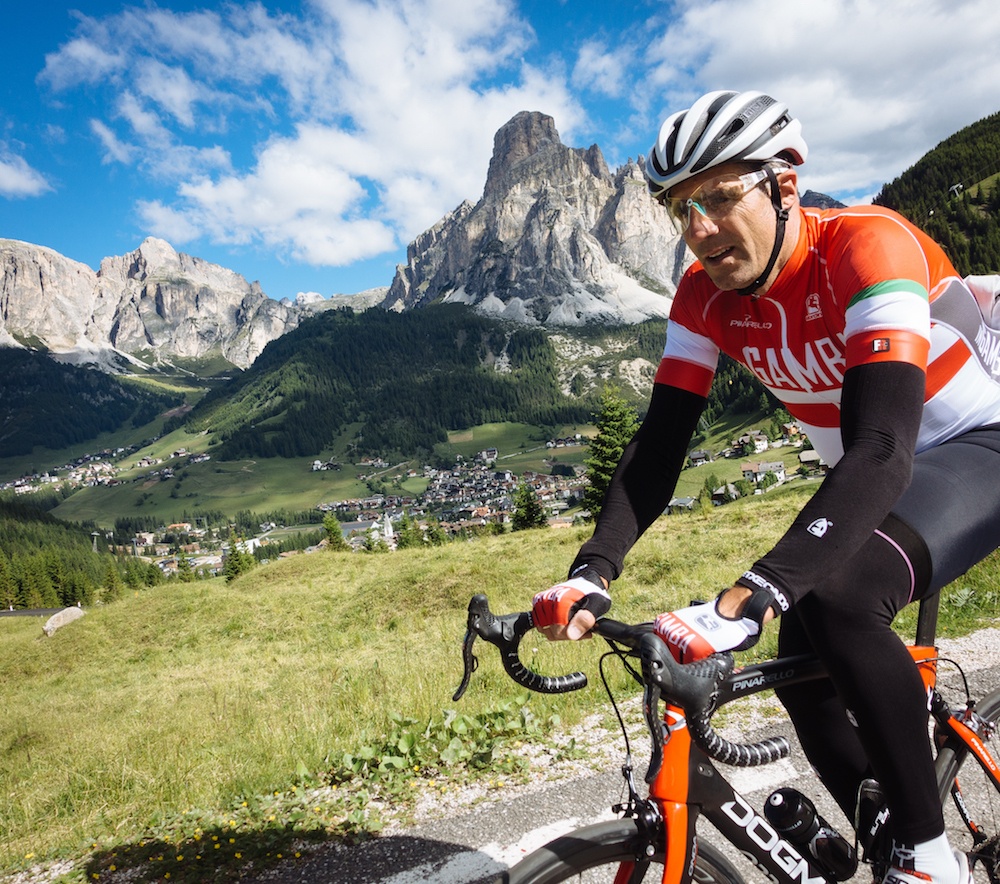We’re all about the little details at inGamba. We like to think our attention to detail is one of the things that sets us apart from the competition. But we’re not against a big gesture, either. And they don’t get much bigger than Big Mig, Miguelón, Miguel Indurain. For the second year running, the most successful ever Tour de France champion will be joining us at our base in the Dolomites, Hotel La Perla, for five days of fun on some of Europe’s most incredible roads.
We’ll be revealing more about the trip and Miguel’s incredible career on our social channels in the coming weeks, but to whet the appetite, we thought we’d look back at a piece our friend Colin O’Brien did for Peloton Magazine on the great Spanish champion.

Miguelón
Colin O’Brien
–
Some grey hairs aside, there’s not much about Miguel Indurain that gives away his age. Now 51, the tall Spaniard possesses a boyish, shy smile and though he retired from the pro peloton almost two decades ago now, he’s still remarkably lean.
Indurain was sometimes criticised for being withdrawn and uncommunicative in his heyday. His teammates joked that when he sat down to dinner you wouldn’t even hear his chair move. But there’s no coldness to the man. He’s not even shy. He just doesn’t want to the centre of attention, which if you’ve ever met an elite athlete, is incredibly refreshing.
While riding, he chats easily with whoever works up the courage to roll up alongside him. On more than one occasion during his week-long guest appearance in the Italian Dolomites, he politely soft-pedalled to allow riders 10 or 15 years his junior to catch their breath. He even went easy on the journalists. And when a German tourist asked him for a photo atop one of the region’s many famous passes – only to hand the five-time Tour de France champion his camera while he posed solo beneath the altitude sign – he laughed with the rest of us, and waited for the stranger to realise his folly and recognise his would-be photographer.
Back at Hotel La Perla – a favourite of the Pinarello family and so home to a small museum dedicated to their famous bikes – Indurain chats easily, in hushed, unhurried tones about his career. And in the background, that bike, so unlike anything we’ll see again, hanging on the wall. Like a sketch from Pablo Picasso or Joan Miró, a work of art inspired by his imperious ability against the clock, the Espada, a sword for a prince from the Kingdom of Navarre, home of the matadors.
What was your first memory of the bike?
My first race, when I was 12, in my home town, Villava. I remember it because before that I was doing other things, athletics and football. I always did a lot of sport, but I tried cycling and I liked it right away.
Who was your hero growing up?
At the start, I didn’t have any heroes, but as I got older, Bernard Hinault because he had everything. I never saw Merckx or Luis Ocaña, so when I was young it was Hinault.
Were you close to other riders?
I didn’t have friends in the peloton. I had teammates …
Do you have a favourite memory?
The most beautiful moment of my career was the first time I won the Tour – in ’91 [a surprise defeat of the heavily-favoured Greg LeMond]. Since I started cycling, the Tour was always the biggest race so to arrive on the Champs-Élysées with the yellow jersey was beautiful.
Your biggest rival?
There was more than one. Gianni Bugno and Claudio Chiappucci, Tony Rominger, there were many …
Any regrets?
I won the Tour, the Giro, but never the Vuelta. I came second, but in seven attempts I never won and that’s missing. In those days it was held in April and I never went well at that stage of the season, when it was cold and also because I suffered from hay-fever in the spring.
I’m missing some races from my palmarès. I never won the Worlds road race. I came second, third, fifth … I won the time-trial, but never the road. I’m missing a big classic, but you can’t win everything.
They said his resting heart rate was 28 and that his lung capacity was eight litres, but he claims never to have measured it. Passion is what counts most, he says, and you can’t quantify that in the lab. Nor should it be measured by how loudly someone shouts. They called him Miguelon – Big Mig – for his stature and his achievements rather than his mouth. He let his actions speak for themselves, and those actions would never have been possible without a vigorous desire. Two Giro-TdF doubles, seven grand tours, an hour record, olympic gold, the rainbow stripes. Everything, no, but more than enough.

–
You can read another of our pieces on Big Mig here.














